But ushered in the nullification of the redeemed Magneto and quite a few unresolved plots.
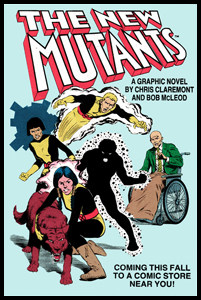
Click for Larger version
"Since the spring of '81 Weezie (X-Men Editor Louise Jones) and I have on various occasions kicked around the idea of doing a second (X-Men) book," writer Chris Claremont revealed in The X-Men Companion. "We decided to wait until we found someone (to draw the book) and then think seriously about putting it together."
"We were afraid that we would go to (Marvel) and say, "Hey, let's do an X-Men book," and they would say, "Yes, but the only person available is" somebody that we wouldn't be interested in using," Louise Jones added. "So we were going to keep our mouths shut until the spring. We were going to pick our people and then we were going to say, "Hey, we've got a book for you.""
"Right. With three issues in the drawer," Claremont continued. "And what happened was that while we were pretty much solidifying the concept or at least getting it as much into focus as we felt we needed, Mark Gruenwald went into (Editor-In-Chief) Jim (Shooter)'s office with a proposal for an alternative X-Men book involving the "loose" members of the original team Angel, Iceman, Beast, Havok, Polaris and I suppose any other extraneous mutants that happened to be around, and setting them up on the West Coast as a kind of a"
"X-Men West," Louise Jones cut in.
"And regardless of the individual merits of the concept, it was way different from what we had in mind," Claremont continued. "Jim quite properly went to Weezie and said that this proposal had been made to him, and asked if we had any problems with it or suggestions, or comments. Weezie pointed out, well, we had our own concept in the works, and we'd had it for quite some time. And Jim said, "Oh, okay, well, let's hear it." So then we had to put up or shut up."
"And luckily at about the same time (artist) Bob McLeod had just surfaced (...) and the pieces all meshed together."
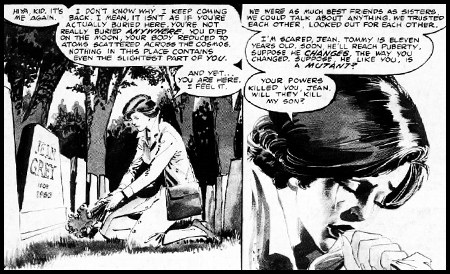
The fate of Sara Grey and her children
"There are lots of characters on tap," Claremont revealed in The X-Men Companion. "We've got Jean (Grey)'s sister's children to think of. (...) She knows about the X-Men and she knows that the kids may be mutants."
"We're sure that they'll be showing up," Louise Jones added. "We think maybe they're twins, but we're not sure."
"Maybe a girl and a boy," Claremont continued. "Tentatively we're dealing with one as a projecting and one as a receiving empath."
In Bizarre Adventures #27 from 1981, Jean Grey's sister, Sara Grey, was wondering if her 11-year old son, Tommy, would become a mutant. However, Tommy never appeared in the New Mutants or anywhere else, but the twins, Gailyn and Joey, ended up appearing in the pages of X-Factor instead. In Uncanny X-Men #215 from 1987, Wolverine and Storm visited the ruins of Sara's home, which had been blown up by mutant haters in X-Factor #12 the same year. Sara and her children had disappeared before the explosion, however. The twins appeared in X-Factor #35 in 1988, written by Louise Simonson (formerly Louise Jones), as part of the villain Nanny's group of orphaned mutants. They were liberated from Nanny in X-Factor #40 in 1989. Sara's fate remained unresolved, so the twins were placed in the care of their grand parents.
"What about Jean Grey's sister?" subsequent editor Bob Harras asked in X-Men Anniversary Magazine 1993. "(Writer) Peter David was originally going to do a bookshelf which would have handled that question, but he never got around to it."
In X-Men vol.2 #36 from 1994, written by Fabian Nicieza, the villain Stephen Lang revealed that Sara had been absorbed by the techno-organic Phalanx race. In X-Man #30 from 1997, written by Terry Kavanagh, Sara had been declared dead. The father of the twins, whose name was revealed to be Paul in Bizarre Adventures #27, 1981, only appeared once in X-Men #138 in 1980, and in X-Man #30 in 1997 the last name of the twins was revealed to be Bailey, although they were still living with the Greys.
Then, in Uncanny X-Men #466-468, 2006, written by Claremont, the entire Grey family, including the twins, were killed off.

A.I.M.'s mysterious Matrix project
"Hopefully, the second book will allow us to better utilize a number of supporting characters who are more noticeable in The X-Men by their absence, such as Moira (MacTaggert)," Claremont told The X-Men Companion. "Karl Lykos gets reformed in Marvel Fanfare #4 (1982). Once he's cured, he'll come into the series as the in-house physician."
However, Karl Lykos never appeared in the New Mutants. Instead, the part of in-house physician went to a new character, Sharon Friedlander.
According to The X-Men Companion, Wolfsbane was originally intended to be a fundamentalist Moslem from Iran. However, there was already a darkhaired female, Psyche, in the group, and rather than remove or change her, it was decided to change Wolfsbane's nationality and appearance into the redhaired Scott and fundamentalist Christian, Rahne Sinclair.
In Amazing Heroes #16, Claremont related an untold tale from Psyche's past: "She was in school. A teacher came over whom she respected and liked. Without meaning to do so, she reached into his head and pulled out a subconscious image of him hacking her to pieces with an axe. And of course, it later turned out that the man was a notorious axe murderer who had killed two or three kids in that part of the state. And that revelation so rattled him that he came after her, and tried to hack her up, and that's how they caught him."
In New Mutants #5-6 from 1983, the villain Viper forced the motorcycle riding heroes Team America to break into the A.I.M. organization's Matrix project to steal a crystal for her. It was never revealed what she wanted the crystal for or what the Matrix project was about.
When the Matrix project blew up, Professor Xavier was overwhelmed by the birth of a powerful new mutant. It is possible that it was actually the rebirth of the villain Shadow King following his demise in X-Men #117 in 1979, as he possessed Karma at the story's climax. However, this has never been confirmed. Claremont never wrapped up the loose ends and subsequent writers didn't follow up on the story, either.
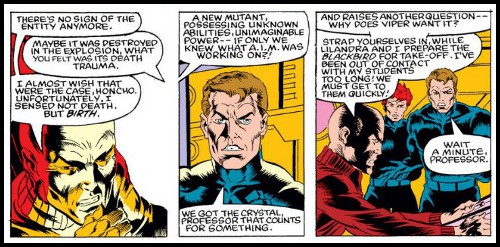
Karma's missing siblings
In New Mutants #46 from 1986, Karma's two smaller siblings, Leong and Nga Coy Manh, disappeared in the same manner as Sara Grey and her children had, suggesting a connection. Karma left the New Mutants in #54 in 1987 to find Leong and Nga and reappeared in Wolverine vol.2 #4 in 1989, where she served her uncle, General Nguyen Ngoc Coy, hoping to use his contacts in the criminal underworld to find the children. Unfortunately, Claremont only wrote nine issues of Wolverine, and of the subsequent writers only Jo Duffy used Karma, in Wolverine vol.2 #27-30 in 1990, wherein Karma left her uncle's employ.
It would be years until the storyline was touched upon again. Leong and Nga didn't reappear until X-Force #62 in 1997, written by John Dokes. They were being held prisoners by an unnamed organisation that was using them in experiments to remove the mutant gene. Before X-Force were able to free them, the children were given to the villain Spiral, but in the 1997 Beast mini-series, written by Keith Giffen and Terry Kavanagh, Karma was finally reunited with them, although Spiral had made them into mature and fully developed mutants.
In X-Force #75, 1998, Karma had found a doctor who thought he could undo the damage Spiral inflicted upon Leong and Nga, and when Claremont returned to Marvel, he wrote the 2002-2003 Mekanix mini-series in which Leong and Nga had become children again.
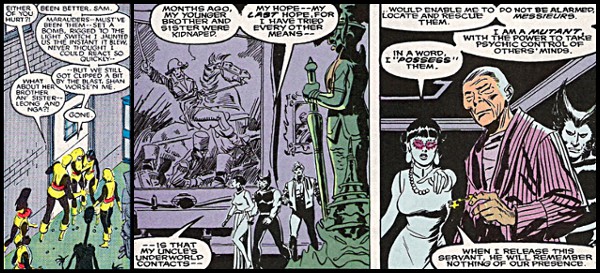
Magneto development nullified
In New Mutants #35 from 1986, the X-Men's former archenemy, Magneto, became the new Headmaster at Xavier's School For Gifted Youngsters. In Marvel Age #33, it said: "The young students get a new teacher and not one they like or trust. In fact, one of the New Mutants is going to quit and join the Hellions."
But as it turned out, nobody ended up quitting and joining the Hellions at this point.
In New Mutants #54 from 1987, it was announced that Chris Claremont would take a six-month break from writing the title. "It was originally only going to be for six months until we got Excalibur out of the way," Claremont told Comics Interview #56. "Then once Excalibur got out of the way suddenly we had like four or five more titles on the horizon, and (fill-in writer) Weezie (Louise Simonson) was having so much fun with (New Mutants) and was doing such a good job that it seemed pointless to take it back."
Unfortunately for fans of the New Mutants and their teacher Magneto, the change in writer meant an immediate change in character portrayal. For instance, Claremont had spent a handful of years developing Magneto from a simple, powerhungry lunatic into the noble Headmaster of Xavier's School For Gifted Youngsters, but it only took Louise Simonsen about two years to reduce him to once again being a powerhungry villain. In New Mutants #75 from 1989, she wrote that Magneto had just been playing the X-Men and the New Mutants for fools in a bid to gain power over all mutants.
"The reason I brought Magneto in as Headmaster was that I wanted to change the dynamics of the school, and I wanted to change the dynamic of Magneto," Claremont told Seriejournalen.dk. "I wanted to redeem him and I wanted a new brand of villains for the 80s and 90s. That ran into a lot of opposition and was ultimately nullified."
"A lot of people didn't like - and don't like - what I did with Magneto from the perspective that they felt it emasculated what they thought was a great villain," Claremont added in Back Issue #4.
"I planned to keep him at the school, as Headmaster of The New Mutants, at least through (Uncanny X-Men) #300 (in 1993) when I thought to confront him with consequences of his former life as a super-villain and force him to make a choice on which side of the line he stood," Claremont wrote in his Cordially Chris online forum.
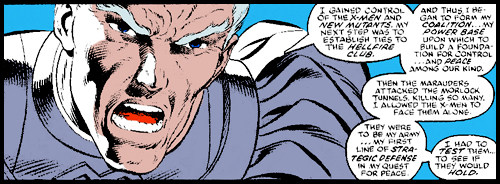
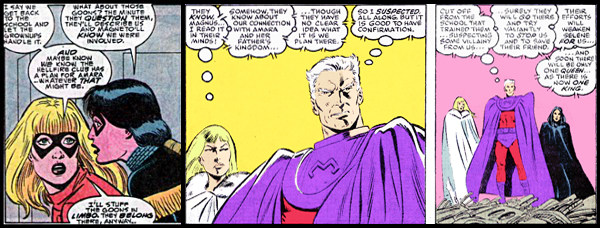
Mysterious plans for Nova Roma
In New Mutants Annual #4 from 1988 and in New Mutants #75 from 1989, both written by Louise Simonson, Magneto and the White Queen of the Hellfire Club harbored mysterious plans involving New Mutant Magma (Amara Aquilla), the city of Nova Roma and their colleague in the Hellfire Club, the Black Queen (Selene).
"There will be a story in the New Mutants involving Amara's country, Nova Roma, and the Hellfire Club will be involved with that," X-Men Editor Bob Harras revealed in Marvel Age #78, but such a story never appeared and Magneto and the White Queen's plans were never revealed.
"The problem was that for me putting an ancient Roman city (Nova Roma) in the jungle was Edgar Rice Burroughs meets Arthur Conan Doyle," Claremont told Seriejournalen.dk. "This is fun!"
"Actually it was a Roman Incan city, so you had mixed elements. That didn't sit well with the new writers on the book, so they blew it up."
Nova Roma was nullified in New Warriors #31 in 1993, written by Fabian Nicieza. When Claremont returned years later, he brought Nova Roma back without explanation in X-Treme X-Men #34 in 2004.
Marvel Age #79 from 1989 had a mention of New Mutants #81 that promised: "What if the prince of your dreams turned out to be a nightmare? For Amara, that's exactly what she faces for the prince she's being forced to marry is a vampire! Will the New Mutants be able to rescue her from an undead fate worse than death? Written by Louise Simonson, pencilled by Bret Blevins, and inked by Al Williamson."
In Marvel Age #80, it said about New Mutants #82: "Is Amara falling in love with the vampire she's being forced to marry? Her change of heart makes matters worse for everyone! In fact, the New Mutants may not survive the latest challenge to the wedding! Written by Louise Simonson and pencilled by Rob Liefeld."
However, that storyline never appeared either. Instead, New Mutants #81 featured a story by guest-writer Chris Claremont, and New Mutants #82 continued the New Mutants in Asgard storyline from New Mutants #80 drawn by Bret Blevins. Rob Liefeld didn't start drawing New Mutants until #86 in 1990.
In Marvel Age #78 Bob Harras also talked about a second Fallen Angels Limited Series written by Jo Duffy, pencilled by Colleen Doran, and inked by Terry Austin, but that never appeared. The first Fallen Angels series from 1987 had originally been advertised as Misfits in New Mutants #36 in 1986 before it was changed to Fallen Angels.
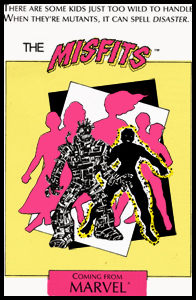
Click for Larger version
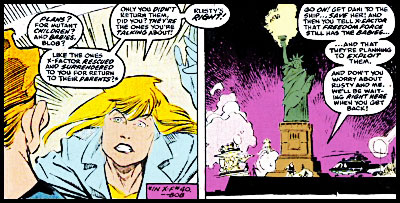
The 13 Inferno babies, Cougar and Cable
Following the 1989 Inferno crossover, Freedom Force, Mystique's team of government sanctioned mutants, got the task of returning 13 stolen babies to their parents, and in X-Factor #40 from 1989, written by Louise Simonson, they also got tasked with returning home some of the child mutants which X-Factor had liberated from the villain Nanny.
In New Mutants #78 from 1989, also written by Louise Simonson, Blob of Freedom Force said that the government had big plans for the babies and the mutant children. Freedom Force stopped two of the New Mutants, Rusty Collins and Skids, from telling the story to the media in New Mutants #86 in 1990, but since New Mutants #87, where Rusty and Skids joined the Mutant Liberation Front, nothing further was mentioned about the fates of the babies and the mutant children.
Then, 20 years later in 2010, New Mutants vol.3 #16 written by Zeb Wells revealed that the military had aquired the babies and experimented on them until they were ready to be used as "mutant weapons."
In Marvel Age Preview #1 for 1991, it said about the New Mutants: "Romance continues to bloom for Wolfsbane and Rictor, but the Mutants' new member, Cougar, adds confusion to the budding relationship."
However, Cougar never appeared in the New Mutants, although a cover for New Mutants #87 featuring Cougar was made. Instead New Mutants #87 from 1990 came to feature the first appearance of Cable. "(Editor) Bob (Harras) wanted the New Mutants to have an adult leader, because Professor X was gone," Louise Simonson recalled in Comics Creators On X-Men. "I had thought that the New Mutants would be perfectly fine without an adult around, but Bob wanted one."
"I came up with the character and what his motivation was. (Artist) Rob (Liefeld) came up with the character design. Actually, his original character design was supposed to be for Stryfe, but Bob and I thought it would be better for Cable. I thought about calling him Commander X at one point, but Rob wanted to call the guy Cable and I said, "You know what? Sure, Cable is a fine name." Anything to get Rob interested in the stories."
"It took me about six months to figure out that Rob really wasn't interested in the stories at all. He just wanted to do what he wanted to do, which was cool drawings of people posing in their costumes that would then sell for lots of money."
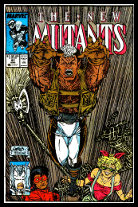
Click for Larger version
Cable became Ahab
In Uncanny X-Men Annual #14, 1990, written by Chris Claremont, it was implied that Ahab, the mutant hunter from the future of Rachel Summers, was that timeline's version of Cable. Rictor also noticed Cable's likeness to Ahab in New Mutants Annual #6, 1990, written by Louise Simonson. However, subsequent writer, Scott Lobdell, made a new character, Rory Campbell, into the person with the potential to become Ahab in Excalibur #75 in 1994.
With New Mutants #98 in 1991 writer Louise Simonson was replaced with Fabian Nicieza and shortly thereafter the New Mutants became X-Force.
"Rob (Liefeld) was unhappy with the way the stories were going and wanted someone else to write them," Louise Simonson recalled in Wizard: X-Men Turn Thirty. "I think that at that point anyone who looked like they could produce lots of instant cash for Marvel was likened to a god, and Rob Liefeld looked like he could do just that."
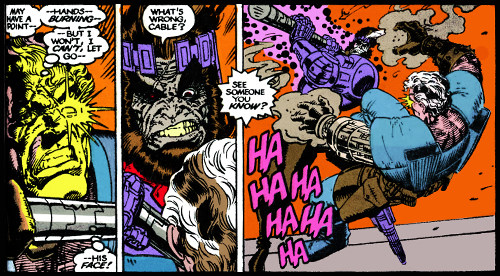
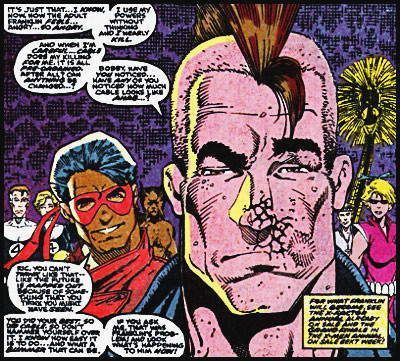
Services no longer required
"Although I wasn't fired, I think I was being shoved out the door with both hands by (editor) Bob Harras," Louise Simonson recalled in Wizard: X-Men Turn Thirty. "Bob was only doing what he had to do, I expect, which was make Rob Liefeld happy. (...) My problems were not so much with Liefeld, because all freelancers are greedy and like to grab what they can, and that's fine. I was an editor for a long time, and I know how that works."
"My problems were really with the editor, who was not handling things well at all. It's up to an editor to choose the people who will work on any given project, and to let them know when their services are no longer needed. I think that Bob was not willing to make those decisions. What he did to me, to Chris Claremont, to Peter David, and to Jo Duffy, was to nickel-and-dime us to death. He would change plots and blame it on the artists. He would change dialogue, and then say, "I'm sorry, but I tried to call you and you weren't home" or "I'll be sure and tell you the next time." He would change some of the dialogue, but not other parts, so the things people said wouldn't make sense. It was his way of letting you know he was wishing you'd go away. Maybe it was time to say good-bye to mutants anyway."
"I had and have a very fundamental vision of who (Dani Moonstar) is and where I wanted to go with her and what I wanted to do with her," Chris Claremont recalled in Uncanny X Cast Episode 77. "I'd like to think if I'd stuck around it would've come to pass. We were setting all this stuff up how she was relating to Asgard and to the Valkyries and especially the relationship between her and Ororo (Storm) and Loki. I had ideas and plans galore for that and I wasn't done with that at all, but that's the nature of the biz."
Sources:
Cordially Chris, comixfan.com/xfan/, 16 June 2003
Tom DeFalco: Comics Creators On X-Men, April 2006
Eric Fein: Bob Harras Interview, Marvel Age #78, September 1989
Paul J. Grant: Poor Dead Doug, And Other Mutant Memories, Wizard: X-Men Turn Thirty, August 1993
Marvel Age #33, December 1985
Marvel Age #79, October 1989
Marvel Age #80, November 1989
Marvel Age Preview #1, 1990
Patrick Daniel O'Neill: Chris Claremont, Comics Interview #56, 1988
Peter Sanderson: The X-Men Companion II, September 1982
Peter Sanderson: The New Mutants - Professor Xavier's New Freshman Class, Amazing Heroes #16, October 1982
Peter Sanderson: Pro 2 Pro Claremont And Byrne: Wolverine At 30, Back Issue #4, June 2004
Tue Srensen and Ulrik Kristiansen: Chris Claremont Interview, seriejournalen.dk, 1995
Uncanny X Cast Episode 77, pod-cast, 2009
X-Men Anniversary Magazine, September 1993
